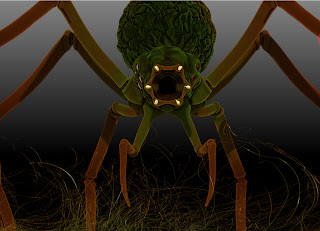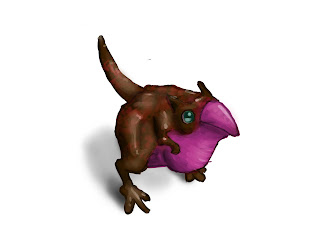1. Once the model sheets were completed, the base mesh was created using ZSpheres. An adaptive skin was attached to the model once the ZSphere armature was completed.
2. The adaptive skin was changed to a Dynamesh skin. Dynamesh allows the polygons to update as mass is added to or taken away from the model. This ensures that the distribution of polygons across the model is always the same. The main forms of the creature were fleshed out during the stage.
3. Once the main form was satisfactory, muscles were added using reference to dog anatomy. Tendons and other smaller forms were fleshed out.
4. The feet were created by continuosly adding mass at the base of each of the toes, with an extrusion effect. Once they were blocked in they were moved and refined with the smooth tool.
5. The claws were made as separate objects, and then each one painstakingly placed in the correct position at the end of the toes. Detail was added to the foot in the form of veins and texture.
6. The head was fleshed out in much the same way as the foot, by layering new geometry and then refining with the smooth tool. The eyeballs were placed into the head as separate objects so the eyelids could be modelled around them.
7. The resolution of the Dynamesh is increased, which increases the amount of polygons. This in turn allows more in depth detailing, which has been done here to add the wrinkles to the snout using the Slash tool.
8. The resolution is increased again and even finer detailing is done. Wrinkles are added to the neck, and texture is added throughout the model using Alpha brushes.
9. Once the detailing is complete, the model painted. A green base coat was used, and then painted on using a variety of techniques including masking and alpha patterns.
10. The painting in progress.
11. Once the paintjob was finalised, the material of the creature was changed to give it less of a shine. A plinth was constructed to be used for turntables.
12. Once the modelling and painting were finished, the model was retopologised using ZBrushes default retopology tools. Each of the new vertices is placed on the high res model and maneurved into the desired position.
13. The aim was to have less than 5000 polygons for the whole model, allowing it to be used in games.
14. Here is the low polygon model loaded into maya. The normal and diffuse maps were transferred onto the low polygon model from the high res models data.
15. The topology of the model in maya. The polycount is 2419 faces.
16. As a finishing touch, part of the creatures environment was added to the plinth. This helps to demonstrate his camoflage and overall adds interest to the turntable.





















































